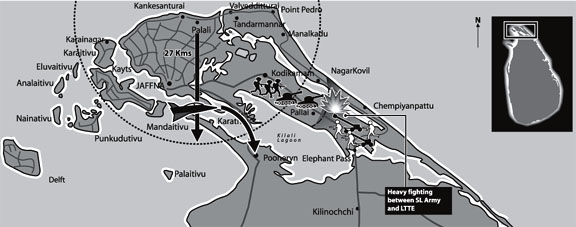Intelligence reports say
Mass burials of 196 LTTE cadres

 During the past few weeks, security forces monitored a heavy LTTE build
up in the Northern theatre. The Tigers had been fortifying their defence
ahead of the security forces forward defence lines in Killali, Nagar
Kovil and Muhamalai. During the past few weeks, security forces monitored a heavy LTTE build
up in the Northern theatre. The Tigers had been fortifying their defence
ahead of the security forces forward defence lines in Killali, Nagar
Kovil and Muhamalai.
This was after the security forces pushed back the Tigers from their
original forward defence positions in Pallai from where the LTTE carried
out its failed offensive to lay siege to the city of Jaffna during mid
August. Since the security forces pushed the Tigers to their secondary
defence line in the first week of September, the LTTE had been
fortifying its positions.
The LTTE began its failed offensive to lay siege on the city of Jaffna
on August 11.
First day
During the first day of the Tiger onslaught on the security force’s
Northern forward defence lines, troops pulled back from several of its
forward defence bunker lines as a tactical move.
After two weeks of fierce fighting, during which the Tigers made
several abortive attempt to overrun the security forces FDL, troops
regained its lost bunker lines.
Later in the first week of September, troops in a decisive push into
Tiger territory, captured the forward defence line of the LTTE, pushing
Tigers in to their secondary defence line.
Since then, the LTTE fortified its new positions to mend off against
a possible security forces advancement. While fortifying its defence,
the LTTE stepped up artillery and mortar attacks on the security forces
FDL positions. Early this week a soldier was killed and three others
injured in a LTTE artillery strike on a FDL position in Muhamalai.
Israeli built Kfir fighter jets conducted daily sorties on the LTTE
artillery and mortar positions. Though such measures could contain the
LTTE build up, it could not totally neutralise the Tiger artillery
attacks on the security forces positions. Artillery dual between the
security forces and the LTTE had been a daily routine in the Northern
front in the past few weeks.
In the early hours of Wednesday, this week, ground troops advanced
from three fronts in Kilali, Nagar Kovil and Muhamalai.
Security forces said they retaliated after repeated harassing attacks by
the LTTE attack on the security forces forward defence line.
Troops advanced one km into the Tiger territory. The plan was to
neutralise the first line of LTTE defence, which was used to conduct
frequent harassing attacks on the FDL positions of the security forces.
Heavy fighting erupted as the troops advanced.
In the Kilali front, Three companies of infantry troops, supported by
armoured tanks broke through the first line of the LTTE defence. The
troops in the Kilali front pushed towards the secondary defence line of
the LTTE. What caused the troops to advance further contrary to initial
plan is not clear.
In the meantime, heavy fighting raged in the Muhamalai and Nagar
Kovil fronts with the infantry troops and the LTTE cadres defending a
well entrenched first line of the LTTE bunkers.
As the troops in the Nagar Kovil and Muhamalai fronts were locked in
combat, troops in the Kilali front advanced further in to Tiger held
area.
They came under stiff resistance from the second line of the LTTE
defence.
As they fought the heavily entrenched Tiger cadres, the infantry
troops came under heavy volume of mortar and artillery fire directed
from Pooneryn, on the other side of the Kilali lagoon.
The troops were locked, fighting the Tigers on three fronts. Air
support was of little use as fighting turned to be a close combat. Heavy
clouds further affected the impact of air attacks on the artillery and
mortar positions.
Fierce battle
The troops fought under extreme conditions. They were locked in a
fierce battle, almost surrounded by three fronts. They could expect
little help as troops were bogged down in the other two fronts.
They fought valiantly, amidst a rain of shell fire. Their valour
would be remembered for years to come by the nation and their comrades
of arms. They were an embodiment to professional soldiers who stood by
their vow to the nation in the face of extreme conditions. They fought
against one of the most entrenched enemy positions. Disengaging from the
battle, they pulled back to their original positions. Many died in the
battle and many more suffered serious injuries.
Later on Thursday, ICRC handed over to the security forces, bodies of
74 soldiers who paid the supreme sacrifice.
Two hundred and eighty declared as Wounded in Action, which included
P1 and P2 injuries. Two hundred others, suffered minor injuries. Several
tanks and armed personnel carriers were disabled in the enemy fire.
Set against this backdrop, Wednesday’s battle was a costly
confrontation. It was the largest number of casualties suffered in a
single day by the troops since the signing of the ceasefire agreement.
The LTTE initially down played its battle losses and then went in to
a deep silence. However, one senior LTTEer had admitted -speaking to a
journalist off the record- of serious casualties on the LTTE.
According to intelligence sources, the LTTE had buried 196 fallen
cadres on Friday in mass burials held in several locations. Mass burials
have been held in Thunnukai, Mannar, Kilinochchi and Omanthai.
According to local sources, the LTTE requested locals to donate blood
for the large number of LTTE cadres wounded in action. According to the
local sources as quoted by intelligence sources, 312 LTTE cadres were
undergoing treatment at various hospitals in the Wanni as of Friday.
Wednesday’s battle was decisive to the LTTE. It had mobilised all
available resources to counter the advancing troops. The strength of a
number of fighting formations of the LTTE — including Charlce Anthony
‘Brigade’, the all female Malathi ‘brigade’, the all female Sothiya
‘Brigade’ and Ellalipadai (border guards)— were depleted by the security
force’s counter offensive in the month of August.
The Sunday Observer reported a few weeks ago, quoting
intelligence sources that Imran Pandiyan, a unit specially assigned for
the security of Tiger supremo Prabhakaran was not mobilised for the
August offensive and could be used for a future attack. It has now
transpired that it was Imran Pandiyan, led by Theepan, a ‘Colonel’ in
LTTE ranks, which fought the security forces on Wednesday.
Indirect fire, both mortar and artillery was instrumental for the
greater part of the security forces casualties on Wednesday’s battle.
Since the Operation Rivirasa which recaptured Jaffna peninsula, 81 mm
mortar was the main cause for the greatest number of security forces
casualties.
81 mm mortar can be fired up to a distance of 5 km.
However, according to the security forces, the LTTE on Wednesday used
much heavier 120 mortars known as arti-mortars. Since, its failed August
offensive, an LTTE build up is observed in Pooneryn, on the other side
of the Killali lagoon. The LTTE had set up mortar and artillery
positions in Pooneryn. During its bid to lay seige to Jaffna, LTTE
targeted the Palali Military Airport with the 130 mm long range
artillery guns positioned in the Pooneryn point.
How LTTE came to possess 130 mm artillery is a mystery. Though
security forces had lost several pieces of 122 mm artillery when LTTE
overran the Mullaitivu and Kilinochchi military camps in 1997 and 1998
respectively, no 130 mm artillery guns ever fell into the hands of the
LTTE during the 20 years of secessionist war.
The LTTE, however, first used 130 mm guns when it overran the EPS
military garrison in 2000. It is believed that the Tigers had purchased
the guns from East Asian source and smuggled them to the Wanni.
LTTE is believed to have three pieces of 130 mm guns, according to
the intelligence sources. 130 mm artillery gun has an effective range of
27 km. The Pooneryn Point known as K point holds a unique importance to
the LTTE due to its geography. Of all the areas held by the LTTE in the
South of security Forces forward defence lines, it is only the Pooneryn
point which comes within 27 km radius from the Pallali Military Air
port.
Defence lines
However, the size of the Pooneryn point, it is a 400 meter wide
strip, imposes severe restrictions on manoeuvrability of the LTTE.
Artillery positions are vulnerable to the air strikes. When the
Tigers attempted to overrun the security forces forward defence lines in
August, the LTTE strategy, as analysed by a senior security forces
official was, to bring its artillery guns upwards from its current
locations in Pallai and Pooneryn, having pushed troops up to Kodikamam
during the first phase of the offensive.
Had the LTTE succeeded doing so, it could have brought the
Kankasanthurai Harbour, the Karainagar Naval Base and the Pallai
Military Air Port within its artillery range.
But the troops fought back, repulsing Tiger onslaught and inflicting
heavy damage on the enemy.
Distinctive strategies
According to a senior military official, there are two distinctive
strategies put in place by the LTTE in the East and the North. The LTTE
did not opt to hold the ground in the East, even during the peak of its
hold, which was during the time of Eastern Tiger commander
Vinayagamoorthy Muralitharan alias Karuna. That was despite the fact
that during the height of Karuna, LTTE had 5,000-6,000 fighting cadres
in the East.
The LTTE carried out attacks on the camps, but did not opt to hold
the ground. Whereas in the North, Tigers had been fiercely fighting to
halt advancing troops since the Operation Jayasikuru.
The LTTE strategy in the North is a different one. The LTTE has shown
a fierce will to fight despite heavy casualties in order to hold ground
under its control and also keep its morale intact.
Government’s position is outlined by the Defence Affairs spokesman
Minister Keheliya Rambukwella who has repeatedly vowed to retaliate
whenever the national security is at stake.
Indeed, what the Tigers fought in their defence lines was a battle of
paramount importance for the existence of the LTTE, militarily and
politically speaking. Had it given up easily, it could have severely
negated the bargaining power in the next round of peace talks, at least
speaking on the LTTE thinking which view military strength as the core
of its bargaining power.
Deep silence maintained in the aftermath of the battle is further
proof for the heavy casualties of the LTTE.
However as a senior military official analysed the priorities in the
aftermath of the Wednesday’s clash, the paramount task at the moment is
to consolidate the current FDL positions of the security forces, there
by preventing the LTTE from exploiting the situation.
Having done that, the security forces could decide the next course of
action considering on the outcome of the peace talks set for end of this
month. |




 During the past few weeks, security forces monitored a heavy LTTE build
up in the Northern theatre. The Tigers had been fortifying their defence
ahead of the security forces forward defence lines in Killali, Nagar
Kovil and Muhamalai.
During the past few weeks, security forces monitored a heavy LTTE build
up in the Northern theatre. The Tigers had been fortifying their defence
ahead of the security forces forward defence lines in Killali, Nagar
Kovil and Muhamalai.






